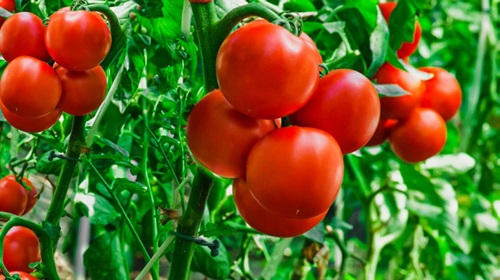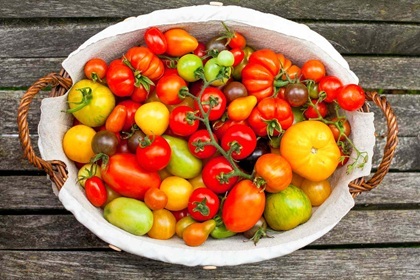May 8th 2025
How to Grow Hydroponic Tomatoes Indoors: Step-by-Step Guide
Regardless of whether you classify them as fruits or vegetables, tomatoes are unquestionably one of our most adaptable foods. The first benefit of growing tomatoes hydroponically versus soil-based techniques is that they may be harvested all year round. Because hydroponic tomatoes are maintained in ideal circumstances and have direct access to water and nutrients, they frequently develop 30–50% faster than their counterparts grown on soil. Some tomato types will thus be ready for harvesting 60 days after planting, if not sooner. In this post, we'll go over everything you need to know about growing tomatoes hydroponically in the comfort of your own home.
Determinate vs. Indeterminate
The two primary growing varieties of tomatoes are indeterminate (cordon) and determinate (bush). Bush varieties are frequently planted with their stems trailing down the edge of pots or huge hanging baskets. Supported by a stake or cane, cordon varieties are taught to grow tall around a single primary stem. Although both varieties may be grown hydroponically, you’ll want to think about your hydroponic setup to help decide which type to grow.

It might be difficult to choose the "best" tomato types for hydroponic farming since there are so many of them—roughly 10,000 in total. Nonetheless, certain varieties often thrive in a regulated indoor setting. Among them are:
- Sun Gold, Sweet Million, Red Robin, and Gardener's Delight are some good cherry tomatoes options
- Black Krim, Cherokee Purple, and Brandywine are examples of heirloom tomatoes
- Red Grape, Juliet, and Tami G. if you want to grow grape tomatoes
Step #1 Selecting the Right Hydroponic System
You must select the appropriate hydroponic system before you can start producing tomatoes. There are several hydroponic systems available, and each has pros and cons. In order to get the best outcome, make sure the hydroponic system you select is suitable for growing tomatoes and contains the tools you need, including net pots, grow lights, and a water pump. Hydroponic towers are a fantastic choice for those seeking a more versatile system, so you can branch out beyond just tomatoes.
Step #2 Choosing Seeds
Selecting the best tomato seeds for your hydroponic garden is the next step. Roma, beefsteak, and heritage tomatoes are just a few of the many different kinds of heirloom tomato seeds available. The kind of hydroponic system you are using, the growth environment, and the lighting conditions should all be taken into account while choosing tomato seeds.
Step #3 The Growing Medium
Coconut coir, rock wool cubes, horticultural foam, Hydroton (LECA clay pebbles), or perlite are typical hydroponic growth media. It's crucial to soak any growth media in water to completely saturate it, regardless of the type you select. This will facilitate the germination process. For hydroponic tomatoes, we suggest using rock wool cubes, horticultural foam, or coconut coir as the growth medium.
Step #4 Choose Nutrients
Apply an appropriate nutrition solution if you want tomatoes to develop robustly, healthily, and produce a lot of fruit. Particularly, tomatoes are plants that require proper nutrition. An organic tomato hydroponic mix with a low nitrogen content would be great. The solution may have a 1:2:2 NPK (nitrogen, phosphorous, potassium) ratio (10-20-20, 5-15-15, or 15-30-20).
The next step is to add the nutrition mix and fill the kit's reservoir with water. The only dosage you'll need is apply the correct ratio of nutrients to water, which is a straightforward yet crucial step. Please read the directions on the bottle or packaging and do as directed.
Step #5 Transfer Seedlings
After you seeds have germinated, they’ll soon be ready to be transferred to the hydroponic system. Moving seedlings into the system using mesh or net pots, is comparable to planting tomato seedlings in ordinary soil. Make sure to provide adequate room and clearance for the plant to grow (upwards or downwards) and for the roots to stretch out.
Step #6 Turn On Your Hydroponic System
Activate the system – including the LED lights, timers, air and water pumps, etc. This can be accomplished with automated timers in the majority of systems. Even if all you do is check the nutrient mix or make sure all the lights and timers are set up correctly, you will still need to check your hydroponic system on a regular basis. Ideally, you should check the pH and EC level every three days. Water should be added to the nutrition mix if the EC level is greater than necessary. You might need to adjust the nutrition mix if it is less than what is required. Additionally, check the system, ideally once every 8–10 days – for obstructions and the formation of algae.
Step #7 Maintain Ideal Growing Requirements
The secret to growing successful hydroponic tomatoes is to create the ideal climate. Make sure they get 12 to 16 hours of light every day, and if needed, use full-spectrum LED grow lights. To replicate natural circumstances, keep daytime temperatures between 70°F and 80°F (21°C and 27°C) and nighttime temps a little lower. Regular temperatures promote fruit production and good development.

To avoid illnesses like powdery mildew, which can flourish in excessively humid conditions, humidity should be maintained between 50% and 70%. For the best nutrient absorption and general plant health, keep an eye on the pH of your fertilizer solution and maintain a range between 5.5 and 6.5.
Step #8 Harvesting and Maintenance
To prevent harming the plant, use pruning shears or clean, sharp scissors while harvesting. To take the fruit without harming the plant, carefully twist or cut the stem. Remove overripe tomatoes as soon as you see them to prevent infections or pests. Tomatoes are frequently harvested continually as they ripen in hydroponic systems, ensuring a consistent supply of fresh vegetables.
Harvesting is just one aspect of caring for your hydroponic tomatoes. Check the plants often for indications of infections or nutritional deficiencies, taking care of problems as they appear. Keep an eye on the surroundings and make any required adjustments to the light, temperature, and humidity.
Final Thoughts
Growing hydroponic tomatoes indoors is a fulfilling experience full of small steps but also full of rewards. With the correct selection, appropriate care, and efficient fertilizer management – you'll soon be reaping the rewards of an abundant crop of delicious, fresh tomatoes.




